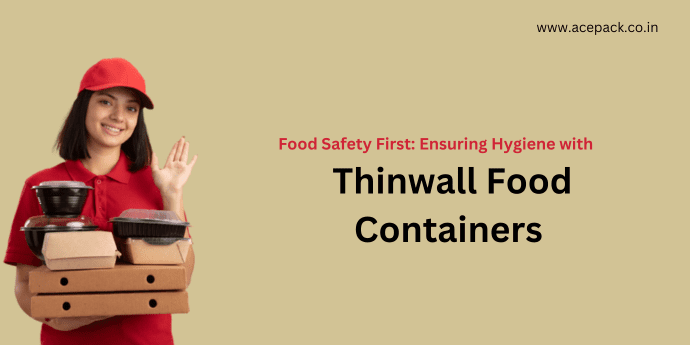
In the world of food packaging, safety and hygiene are non-negotiable. Whether it’s ready-to-eat meals, takeout dishes, or packaged snacks, consumers today expect their food to be fresh, safe, and contamination-free.
That’s where thinwall food containers come into play - lightweight, durable, and designed to meet the highest standards of food hygiene and safety.
At Ace Packaging, we specialize in premium-quality thinwall plastic containers that combine convenience, cleanliness, and sustainability. In this blog, we’ll explore how thinwall food containers help maintain food hygiene while offering unmatched efficiency for storage and delivery.
Thinwall containers are specially engineered plastic containers made using advanced injection molding technology. Despite their light weight, they are strong, durable, and highly functional, making them ideal for both commercial and household use.
These properties make thinwall containers the perfect packaging solution for restaurants, food delivery services, and food manufacturers aiming for both hygiene and cost-efficiency.
Food safety isn’t just about what’s on your plate — it starts from how food is stored, transported, and served. Poor packaging can lead to contamination, bacterial growth, and spoilage.
Ace Packaging’s thinwall containers are designed to preserve freshness and protect against external contaminants, ensuring food remains safe from kitchen to customer.
When you prioritize hygienic packaging, you protect both your customers’ health and your brand’s reputation.
The innovative design and material composition of thinwall food containers make them one of the most hygienic choices for food storage.
Airtight & Leak-Proof Design: Prevents moisture and air from entering, reducing the risk of bacterial growth and spoilage.
Made from Food-Grade, Non-Toxic Materials: Each container is crafted using BPA-free and FDA-approved plastics, ensuring no harmful chemicals come into contact with food.
Resistant to Heat and Cold: Suitable for both hot meals and refrigerated items — maintaining hygiene under various temperatures.
Single-Mold Construction: Fewer joints mean fewer crevices where dirt or bacteria can hide, making cleaning easier and more effective.
For restaurants, cloud kitchens, and catering services, thinwall containers offer a professional and hygienic packaging solution.
By using Ace Packaging thinwall containers, businesses can ensure customer satisfaction while maintaining compliance with food safety regulations.
While thinwall containers are primarily designed for single use, they can be reused with care in non-commercial settings. To maintain hygiene:
These simple steps ensure that your containers remain clean, safe, and effective for repeated use.
Today’s consumers demand packaging that’s both safe for food and kind to the planet.
At Ace Packaging, we’re committed to sustainability by manufacturing thinwall containers that are:
By switching to thinwall technology, you’re not only improving hygiene but also reducing waste and promoting eco-friendly practices.
Our thinwall series is ideal for everything from curries and salads to desserts and snacks - keeping food fresh, safe, and ready to serve.
Maintaining food safety is essential in every step of the food journey - and choosing the right packaging plays a major role.